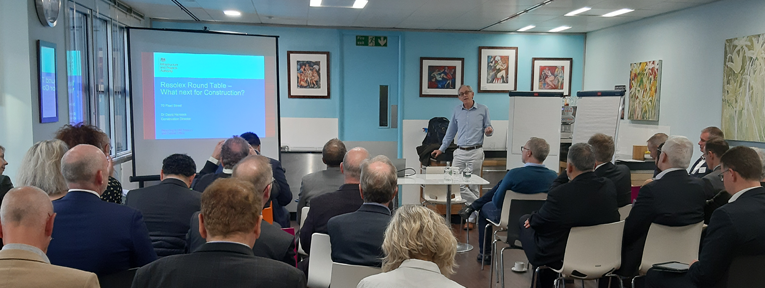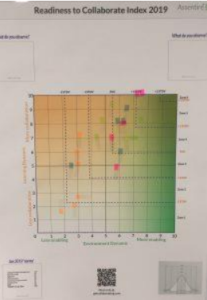
Oct 2, 2020 | News and insight
In Part One of this article I introduced a concept I called the Collaboration Fallacy, which is an inaccurate assumption that multiple teams engaged in a major project will automatically work together in the best interest of the project. My purpose in articulating the idea of the Collaboration Fallacy is to nudge project leaders to recognise that humans do not naturally work as happily integrated units. The project culture in which they operate must encourage them to do so. The concept is an extension of the more widely acknowledged phenomenon known as the ‘planning fallacy’, initially identified by Daniel Khaneman and Amos Tversky. Khaneman and Taversky observed that humans continually underestimate the time needed to complete a project despite the information being available to them that would lead to a more accurate answer.
The key point that I tried to emphasis in the first article is that if project leaders were to take the time to look more closely at the factors that bind or disrupt inter-team relationships, they would take a different view as to what was needed to build a successful team of teams. This is particularly important when stepping up into complex project environments where the interactions between groups of people become one of the most troublesome variables. I have noticed however, a high level of complacency in many senior teams at the start of a large project, where the predominant belief is that everything will be fine, and any problems that arise will work themselves out. Once the behavioural norms are set however, they are very difficult to change.
The challenge, therefore, is to find some mechanisms that will help project leaders avoid this naïve tendency and look more closely at the challenges ahead. Logically, we should start with learning from our past experience and that will help avoid making the same mistakes again. There are thousands of project case studies in the public domain which identify the problems created for teams when working in projects with high levels of ambiguity and frequent change. Auditors and analysts often identify a lack of planning or forethought which might have avoided significant difficulties downstream. I have found, however, that stories of past failure often carry little weight when thinking about future projects and programmes. The prevailing view is that ‘this project is different, so those problems will not occur’. In my research, I have found a richer source of knowledge and learning to come from asking my interviewees to describe a project that went well, rather than one that went badly. This is often an interesting challenge, as successful large projects are much less common than one would think.
The question as to what went well, and why, is intended to draw out the factors that actually turned out to be important to success, rather than the more superficial elements that are more commonly used when planning a project. I have found almost without exception that when a project is considered in hindsight to have been successful, time and resources were spent focusing not just on the technical and commercial challenges but also the social components of team development and interaction.
One simple solution to avoid falling prey to the Collaboration Fallacy is for the senior team to set some time aside in their planning sessions to ask each other to tell a story of what made a past project a success and then crucially, what learning might be taken into the current project. Stories are immensely powerful in helping humans learn; they resonate at both an emotional as well as a cognitive level, so that we remember more of the detail, and attach greater meaning to the experiences of the protagonists. As human beings we are more likely to react to someone else’s story than we are to bullet points in a PowerPoint presentation.
The beauty of this approach is that it diverts the discussion away from the instinctive focus on technical planning which tends to dominate most early senior team meetings. Instead, the question allows each person to slow their thinking and reflect on the past. Once everyone has had a chance to contribute, the session could move onto another crucial question; “What has to go right for this project to be successful?” (It is important to note that what needs to go right is very different to the question of what could go wrong.)
Setting time aside to plan for building positive relationships and interpersonal trust can be distracting when a newly formed team really just want to press on with the process of delivery. The payoff downstream is however potentially huge, particularly when trying to work in a complex environment. So, as you move into your next project, one of the key questions to ask your team is ‘are we in danger of falling for the Collaboration Fallacy here, and if so, what are we going to do about it?’
Tony Llewellyn

Jun 19, 2019 | Events, Roundtables
With Howard Britton
There are not many speakers who invite the audience at the very start of a presentation to regard him as obnoxious!
But Howard is not an ordinary presenter. With a wider and more varied career background than most, including a
period as a practicing Psychoanalyst, Howard is well qualified to provide a fresh perspective on the topic of diversity.
Howard invited us to join him on a journey of thought, which he divided into three parts.
PART ONE – TEAM ARCHETYPES
Howard suggested that there are four common character types that can be found in most teams.
TYPE 1 – THE ‘IDEAS’ PERSON This is an individual who is constantly thinking of new ways of doing things. People like this are typically regarded as mavericks.
TYPE 2 – THE ‘GRAVE DIGGER’ A person who seeks order and needs to sort everything into neat boxes.
TYPE 3 – THE ‘ENGINEER’ This is someone who loves process and believes in things being done in a particular and consistent sequence.
TYPE 4 – THE ‘DOER’ Someone who likes action and has limited patience with planning. She just wants to get things moving.
The inference as that the motivational drivers of everyone in a team will be influenced by factors that are little to do with
the work environment and are more likely to be shaped by their genetic wiring, as well as their childhood experiences.
Each will have a preference for the type of work they do.
The problem, however, is that most companies do not recognise these differences and often require people
to work in a way that is misaligned with their core drivers, leading to average or below-average performance. Howard then identified several leadership archetypes:
The ‘dense’ leader, who is highly egotistical, believes can do everyone’s job better than they can. This type of leader does not listen and therefore lacks real understanding of what is going on in his team.
The ‘empty’ leader, who has been overpromoted and is clueless as to how to do their job. Ideas and feedback from the team go into a void.
The invisible leader, who is rarely available to her staff, and whose focus is anywhere but on her team. She is continually travelling or in meetings.
The ’Socratic’ leader, who is clear that she doesn’t know everything. She is therefore continually listening to her team trying to understand them. This is the type of manager that is likely to get more productivity from members of her team.
Howard’s point is that in order to successfully manage the four archetypes within the team, leaders must work with their people at the level of their identity. He emphasised that individuals are unlikely to change and so the business must adapt to them to get the best out of them, although this is incredibly challenging.
PART TWO – HIGH PERFORMING TEAMS
Howard noted that in a volatile and uncertain world, many organisations are seeking a step change in how they
operate. This will require a change in organisational philosophy where leaders must identify their vision of a
future state and then work backwards to plan how to achieve it. He cited the example of Dale Evans at Anglian Water who declared a vision for a 50% reduction in carbon from the company’s capital expenditure programme. Dale did not
know how this target would be achieved but engaged the wider team in agreeing a series of steps that would lead to
the desired outcome. These steps forced the team to break out of their ‘business as usual’ mindset and imagine a
different future with a new working philosophy. With such challenges, tapping into the different archetypal drivers
present in the team improves the chances of breaking out of the “business as usual” mindset.
This leads us towards the challenge for leaders and managers to find out what each member of their team is really
good at and harnessing it. Howard suggested that his model of archetypes has some relational aspects, where one
type of person can handle knowledge or information to be passed onto the next type of person by the leadership. In
this way, the team all perform at their best and the best outcome is achieved.
PART THREE – COGNITIVE DIVERSITY
In the final section of his presentation, Howard focused on the distinction between the diversity
of technical skills and emotionally driven cognitive skills. His argument was that whilst a diverse range of technical skills can be taught, emotionally driven abilities are embedded, and cannot be easily learned. Recognising the different cognitive archet ypes is therefore an important element in the success of teams, particularly where the team is being asked to deliver innovation, or a step change from business as usual. Howard consequently separated diversity into three primary elements:
- SKILLS DIVERSITY – knowledge and experience
- IDENTITY DIVERSITY – who we are as a person
- COGNITIVE DIVERSITY – how we think
Howard noted that much of the recent discussion about diversity focuses on the need to include minority groups into
teams who may otherwise be excluded based on their gender, race, sexuality and so on. His view is that this
discussion is much needed to ensure equality of opportunity and that everyone in the workplace is treated with dignity
and respect, regardless of our diverse identities. Howard’s suggestion throughout the evening was that perhaps the second discussion is emerging to resolve the complex challenges today’s project teams face; one that considers
diversity not only from the perspective of our identity but also how to harness the diversity
of our thought to optimise teams and deliver high performance.
Tony Llewellyn, June 2019

Mar 10, 2019 | Events, Roundtables
A short summary of the presentation by David Hancock, Chairman of the Government Construction Board for the Cabinet Office and the Infrastructure and Projects Authority and is also chair of the NEC UK Users’ Group. volume
David’s presentation led to a lengthy discussion and debate from many differing perspectives, considering challenges around risk allocation, industry-level collaboration and the impact of digital technologies on the future of construction and infrastructure delivery in the UK.
David opened the session by commenting that construction in the United Kingdom is currently at the centre of a perfect storm, which will drive change in at least some parts of the industry. Customer dissatisfaction, low (or no) contractors’ profit margins, and a shortage of skilled labour are all creating pressure to find alternative business models. Adding in the rapid digitalisation of many other aspects of the world economy offers a significant opportunity to those firms who are prepared to invest in different ways of working; a huge threat to those that are not.
As chairman of the Infrastructure and Projects Authority (IPA), David has an overview of a huge pipeline of expenditure. The Government is planning to put £600 billion into the country’s infrastructure over the next 10 years. As the biggest client in the country, they have the potential to be a huge influence on the industry. Recognising the importance of their role, the IPA have an ambitious vision to use digital information technology to improve how the public estate is designed, constructed, operated and integrated into the country’s built environment.
The Government is therefore involved in a range of initiatives, one of which is a presumption in favour of offsite construction. Five of the largest government departments have committed to a platform design strategy based around increased standardisation, with the intention that more building components are manufactured in a controlled environment. David acknowledges that offsite manufacturing for construction is complicated and will take time to develop. The future potential benefits, however, are immense, not only producing a better product but also offering the opportunity of significant savings in cost and time.
Construction Innovation Hub
The Construction Innovation Hub brings together world-class expertise from the Manufacturing Technology Centre (MTC}, Building Research Establishment (BRE) and the Centre for Digital Built Britain (CDBB) to transform the UK construction industry.The future potential benefits, however, are immense, not only producing a better product but also offering the opportunity of significant savings in cost and time. Government has chosen three partners to form the Construction Innovation Hub. Aligned with the themes of the IPA publication, Transforming Infrastructure Performance, this Hub is intended to be the centre of excellence, driving challenge and change into all aspects of infrastructure delivery to provide innovation and improved performance and productivity. There is a clear focus on improving the use of digital and advanced manufacturing technologies to provide the benefits required.
“Although there have been developments in BIM and increased uptake of digital technologies, in
construction we still use digital in an analogue way.”
One of the primary barriers the industry must overcome is the low levels of collaboration and connectivity. David provided a graphic illustration showing how weak the networking effect is within construction when compared to industries such as software engineering, manufacturing, financial services and media. The outcome of such low connectivity is the very slow spread of new ideas and limited innovation.
The IPA is also supporting initiatives such as Project 13, where value is based on overall outcome rather than simply looking at cost and programme. They recognise the challenge is to build more collaboration through the industry so that everyone can help make the ‘pie’ bigger rather than simply focusing on their own self-interest. The government has chosen three partners to form a Construction Innovation Hub. These are:
- Manufacturing Technology Centre The Manufacturing Technology Centre (MTC) develops and proves innovative manufacturing processes and technologies in an agile, low-risk environment, in partnership with industry, academia and other institutions.
- Building Research Establishment We are an innovative group of researchers, scientists, engineers and technicians who share a common goal – to make the built environment better for all. We generate new knowledge through independent research.
- Centre for Digital Britain The Centre for Digital Built Britain is a partnership between the Department of Business, Energy & Industrial Strategy and the University of Cambridge to deliver a smart digital economy for infrastructure and construction for the future and transform the UK construction industry’s approach to the way we plan, build, maintain and use our social and economic infrastructure.
The Construction Innovation Hub will support the four key themes around which the IPA is shaping its plans, explained in detail in their publication, Transforming Infrastructure performance.
David closed the session by asking the audience how these plans might have an impact on the day-to-day practices of our own work. For change to take place within the industry each of us should examine how digital transformation could have a positive impact in the way we choose to operate.
His underlying point is that the Government can act as a catalyst for change but finding answers to the challenges posed will require the engagement of individuals and organisations who are prepared to invest time in working through the complexity of the challenge to build for the future.

Feb 6, 2019 | News and insight
Rod is an APECS Accredited Executive Coach, Windsor Leadership Trust Leadership Facilitator, Agile Business Consortium’s Strategy & Leadership Stream member and Co-founder of Assentire Ltd, Accelerating Collaboration Everywhere®.
Rod opened the session by sharing where in Project 13, there are multiple references highlighting the importance of both an enabling Environment Dynamic and effective Collaborative working, emphasising these are both required to enable the desired shift ‘From Transactions to Enterprises’ which is the name of the ICE report referenced. A few of the highlights are listed below:
- Effective organisation: One of the most surprising conclusions to emerge from the consultations with suppliers was how often collaborative teams are hampered by poor organisation. (*1P21)
- We are embracing the creation of value-driven, collaborative teams that can deliver investment programmes that secure the outcomes demanded by clients and the public. (*1P2.1)
- Too often the supply chain that delivers our infrastructure seems locked into a cycle of low margins, low investment and dysfunctional relationships. (*1P2.2)
- Three stages of maturity: It takes time for organisations to move away from the traditional approach and evolve into high-performing shared enterprises. Our studies of projects show that as collaborations mature, the partners become less reliant on the contracts between them and more skilled at managing their combined resources to produce the required outcomes. (1*P16)
- Effective teams are networks of collaborative relationships that encourage an exchange of knowledge and capabilities to drive improvement and innovation. (*1P20.2)
- “When we are confronted with evidence that challenges our deeply held beliefs we are more likely to reframe the evidence than we are to alter our beliefs. We simply invent new reasons, new justifications, and new explanations. Sometimes we ignore the evidence altogether”. (*1P13.2)
- Skills, behaviours and leadership. Alongside the commercial principles, it is essential that the capability is attracted, developed and retained within an enterprise to provide the underpinning leadership, behaviours and skills for success. There are two aspects, 1-Creating the right environment, 2-Skills and behaviours of organisations. (*2P32-34)
Source for Project 13 extracts 1 ‘Transactions to Enterprises’, 2’P13-Blueprint-Web’
Enable and Engage
Drilling down on the 4Es framework, the discussion moved to two aspects, ‘ENABLE’ & ‘ENGAGE’ critical to the ‘project environment’. Within these two areas, there is a need to pay attention to ‘An environment where desired behaviours are enabled is made available ‘and ‘Collaborative networks within enterprise model are enhanced and used to support transformation’.
Having shown the linkage between P13 and the Project Environment highlighting the relationship to Collaboration (i.e. the Environment & Group Dynamic) the talk moved from the traditional slide presentation into an evening based on Gamification. The evening focussed entirely on the Project Environment and how it felt when one reflected on a group or team.
The gamification approach is based on the AcceleratingCollaboration Everywhere® Suite of tools which were developed especially to help enhance skills identified for 2020 by the World Economic Forum’s 2018 Future Skills Report. The top ten were: complex problem solving, critical thinking, creativity, people management, coordinating with others, emotional intelligence, judgement and decision making, service orientation, negotiation, and cognitive flexibility.
By using the Gamification approach, it brought each person’s project to life, enabling them to explore their own project environment in full confidence as no actual attributable detail is shared with others around the table. All people had to do was ask 10 statements, and from the scores, each person had the knowledge of how to create the optimum project environment, enabling autonomous motivation while developing a more expansive mindset, and better understanding of what really gets in the way of major change initiatives.
Each marker on the poster represents the perception of how the Project Environment was perceived in relation to a specific group. The further to the right, the more Enabling the Project Environment was perceived to be. The distribution of stickers suggests there is a correlation between the Project Environment (horizontal scale) and what the Learning Dynamic (vertical scale). If now contrasted with the ‘norm’ group of >400, it’s possible to identify which of the 6 Zones of Collaboration a group falls within. All those that attended the evening left with their personal copy of the 6 Zones of Collaboration information sheet that describes in more detail each of the zones.
 Zone 1: Collaboration is not occurring
Zone 1: Collaboration is not occurring
Zone 2: Collaboration occurs infrequently
Zone 3: Collaboration occurs more frequently, yet by chance
Zone 4: Collaboration occurs more frequently, and by design
Zone 5: Collaboration is understood, supported and cascaded
Zone 6: Collaboration is understood, cascaded and highly adaptable
For more information on the ideas behind this approach, visit https://getcollaborating.com/introduction
where Rod is interviewed by Nigel Paine. ResoLex will shortly publish another video as part of the RoundTable support it brings to the community. Watch this space.
Tony Llewellyn, February 2019

Jan 17, 2019 | Events, Roundtables
Roundtable with Jane Gunn
Jane is a Professional Speaker, Mediator, Facilitator, and One-To-One Coach at Gunn Consultancy. She is Chair of the Board of Management of Chartered Institute of Arbitrators, Past President at the Professional Speaking Association and Owner of Corporate Peacemakers.
Jane opened the session with the observation that many people would rather parachute out of an aeroplane for the first time or even get their head shaved, than address difficult conflict issues at work.
And, yet it is commonly acknowledged that
“whatever is unspoken is the hardest thing to change.”
The basic premise of Jane’s presentation is that organisations should adopt the habit of addressing conflict early, and to do this they need established a clear process.Managing the process is particularly important when collaborating with other teams or organisations, where miscommunication and misunderstanding can quickly descent into conflict.
A large part of the problem is that we ignore the warning signs of early conflict, but because it is an emotive issue, the growth of dissatisfaction is exponential and so when left too long can be explosive.
Jane illustrated the conflict sequence as a stepping process through a number of stages:
Stage 1
The parties stop talking
Stage 2
They talk to others, trying to build support for their case
Stage 3
They start issuing threats
Stage 4
They take action to coerce the
others to concede or be punished
Stage 5
Positions become entrenched as egos become fixated on not losing face
Stage 6
Into the ‘abyss’ together
Conflict management is crucially about identifying conflict early and taking action.
Our brains are wired to be on alert for threat, measuring what is happening in every conversation and non-conversation.
A model for conflict management
Jane drew up a model identifying some of the key aspects of conflict management. Creating a degree of consciousness about these factors will help reduce conflict and allow for faster intervention.
Consideration – Treating others with courtesy
Connection – Being made to feel part of the ‘in group’ or excluding others
Control – A common trigger for conflict is when we feel events are beyond our control Caring – Making others feel they are heard and are important
Culture – How are things done around here
Conditioning – What bad behaviours appear to be acceptable?
The service expected from our leaders has changed and conflict management should now therefore be an important role to build better solutions, without creating the destruction that happens when we enter the abyss.
When asked if there is a particular process that could be adopted, Jane’s view was that it would vary from organisation to organisation and even from team to team. Through the questions that came from the floor, however, some of the important ingredients for conflict management are as follows:
- Having emotionally intelligent people on the team makesa significant difference.
- ‘Fist bangers’ neededhelp to understandthat aggression rarely moved them forward.
- At the start of a conversation, agreeing how we will proceedis crucial.
- Deciding when to act. This is a judgement call,e.g.is this still going to be a problem in two weeks time?
- Encourage self-determination before escalation. Encourage people to sort their own issues rather ‘pass the monkey onto someone else’s back.’
- Where is conflict likely to occur and what preemptive actions can be put in place?
- Encourage the linguistic habits of dialogue over debate.
Jane packed a lot of very useful information into a short session, but the key message I took away from the event was forteam leaders to recognize their potential tendencies to ignore conflict and to take time early in the project cycle to agree a process that encourages healthy disagreement, andalso addresses interpersonal conflict shortly after it starts to emerge.
Tony Llewellyn, January 2019




 Zone 1: Collaboration is not occurring
Zone 1: Collaboration is not occurring